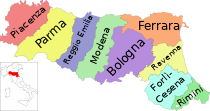Province of Forlì-Cesena
Province of Forlì-Cesena | ||
|---|---|---|
 Palazzo dei Signori della Missione, the provincial seat | ||
|
ISTAT 040 | | |

The Province of Forlì-Cesena (
History
Forlì was founded by the Roman consul Marcus Livius Salinator, and it was connected to the Via Aemilia in 188 BCE. By the 12th century CE, it had become a Ghibelline commune and military garrison.[4] The Holy See initiated a small attempt to rule Forlì in 1278, but the family of Ordelaffi led the city from 1315 until 1480. The city was later governed by Girolamo Riario and his wife, Caterina Sforza; during this period, the Holy See attempted to regain control but was unsuccessful. Spanish Pope Alexander VI ordered his son Cesare Borgia, Duke of Valentinois, to Forlì and other communes in the region; Borgia successfully gained control of Forlì in 1500, but lost it in 1503, after the death of Alexander VI. Until the formation of the Kingdom of Italy, it remained under the rule of the Holy See.[4]
Cesena was first owned by the Romans until the fall of Rome when it was taken by the Byzantine Empire. Following this, it was owned by archbishops of Ravenna.[4] During the period of issues between the Guelphs and Ghibellines, the Holy See took over Cesena from the Ordelaffis. Antipope Clement VII's troops almost completely destroyed Cesena in 1377, and the Pope gave the city to the House of Malatesta. After the House of Malatesta controlled the city from 1378 to 1465, the Holy See regained control of Cesena. Leonardo da Vinci designed the port Cesenatico.[4] It remained under papal rule until Italy was unified.[5]
In 1921, there was a rapid advance of the Fascist movement in the region triggered by issues connected with agrarian reform. Buildings belonging to the republicans and socialists were seized or burnt down by Italo Balbo, and on July 29, he and his men moved throughout the provinces of Ravenna and Forlì, burning every socialist organisation headquarters in a night of terror which was later called the "column of fire". This was a pivotal moment in the advance of Fascism in northern Italy.[6]
On 16 April 1992, the Province of Rimini was formed from the Province of Forlì's southwestern municipalities. The remaining part of the Province of Forlì was renamed the Province of Forlì-Cesena.[7]
Geography
The province of Forlì-Cesena is one of nine provinces in the region of Emilia-Romagna in the northeast of Italy. Along with that of Rimini, it is the most southerly of the provinces in the region and it abuts onto the Adriatic Sea for a short distance. The province of Ravenna lies immediately to the north and the Province of Mantua in Lombardy to the northwest. To the west lies the Metropolitan City of Florence in the region of Tuscany, the province of Arezzo, also in Tuscany, lies to the south, and the province of Rimini lies to the southeast. The provincial capital is the city of Forlì, which is situated on the bank of the Montone river about 70 km (43 mi) southeast of Bologna.[8]
International relations
Twin towns — sister cities
The Province of Forlì-Cesena is twinned with:
 Dongcheng District, Beijing, China, since 2012
Dongcheng District, Beijing, China, since 2012
References
- ^ Regions and Cities > Regional Statistics > Regional Economy > Regional Gross Domestic Product (Small regions TL3), OECD.Stats. Accessed on 16 November 2018.
- ^ "www.gazzettaufficiale.it". Retrieved 2024-01-30.
- ^ "Provincia di Forlì-Cesena". Tutt Italia. Retrieved 19 August 2015.
- ^ ISBN 978-0-313-30733-1.
- ISBN 978-0-313-30733-1.
- ISBN 978-0-520-91069-0.
- ^ "Decreto Legislativo 6 marzo 1992, n. 252" [Legislative Decree 6 March 1992, no. 252]. Gazzetta Ufficiale (in Italian). 6 March 1992. Retrieved 2 January 2024.
- ISBN 9780007419135.

